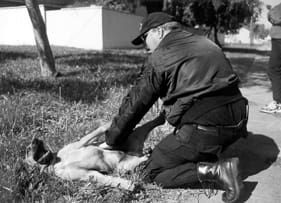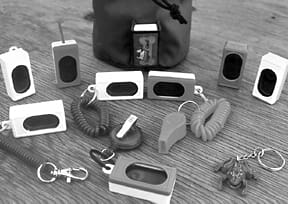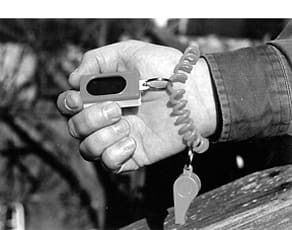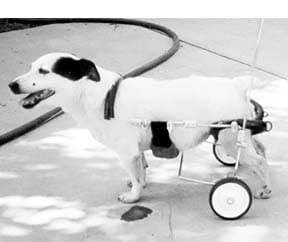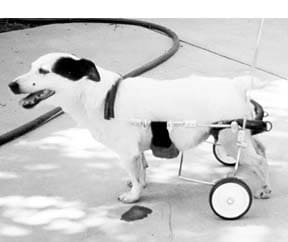[Updated May 23, 2018]
You come in from a jaunt in the woods with your trusty Labrador and notice, as you rinse the mud from his legs and feet with a hose, that he somehow got a cut on his upper leg. You could spray it with an alcohol-based disinfectant, or swab it with an antibiotic cream, in an effort to kill the bacteria that might infect the wound.
But, according to holistic healers, these modern wonder drugs may constitute a chemical overkill, going far past their intended purpose (killing harmful foreign bacteria) and killing the resident beneficial bacteria that live on the dog’s skin. And what sense is there in dragging out the heavy artillery when just a light protective force is needed? Especially when there are natural, effective, inexpensive, and synergistic alternatives: calendula and hypericum, herbs that have been used for centuries for wound care.
Calendula officinalis (also known as the Marigold plant, but usually called calendula) and hypericum (also known as Saint John’s Wort), are very safe, yet incredibly effective at cleaning the site of an injury and encouraging the body to heal. Homeopathic and herbal preparations of calendula and hypericum have proved invaluable in modern-day holistic dog care. In fact, it’s difficult to find an herbal wound preparation that does not contain some form of one or both of these potent plants.
Healing Your Dog’s Wounds with Calendula
Wiki Creative Commons

Calendula is one of the most effective remedies known to mankind for the treatment of wounds. Although it has no antibiotic properties (it does not have the ability to kill or slow the growth of living organisms), calendula seems to help prevent infection by somehow triggering the release of the body’s own antibiotic substances.
Calendula also helps stop bleeding and promotes tissue granulation so that cuts and burns can heal properly. It even helps prevent proud flesh (an overgrowth of granulation tissue, an angry red color, laden with tiny blood vessels that bleed easily). Because of these properties, any wound from a minor scrape to a deep, serious gash can benefit from the use of this medicinal herb.
Cleansing solutions made from calendula tincture can also be very useful. Whereas products like Betadine clean and disinfect wounds, they do not encourage healing. A solution made from calendula tincture cleans the wound, helps stop bleeding, stimulates the body to fight infection, and triggers the body’s own internal wound-healing processes such as granulation. Calendula also demonstrates a potent anti-fungal action and may be used externally to combat such infections.
To start the healing process, promptly rinse the wound with distilled (if possible) or tap water and then flush the site with calendula or a calendula/hypericum solution (see below).
The topical calendula products can be used liberally and frequently. Apply them once a day for minor or mostly healed injuries, or three to five times a day for more serious conditions. Continue using them until the cut, abrasion, or burn has healed completely.
Hypericum Helps with Nerve Damage
Wiki Creative Commons

Hypericum perforatum, usually called hypericum, is used for injuries to nerve endings. It is especially helpful for blows to the extremities like the toes and tail, where there are intricate clusters of nerves. It is also effective for spinal injuries where there is threat of damage to the spinal cord. Because of its ability to repair nerve damage, it helps to relieve pain from any type of blow such as a bruise from a kick or a painful cut. It also helps the body resolve abscesses and infections. In addition, it can be effective in preventing tetanus.
Hypericum works beautifully in wound care when applied topically along with calendula. Use the combination formula described below to flush wounds and promote tissue and nerve healing. For a wound that needs regular cleaning and dressing, use the solution every time you treat the injury.
Making a Calendula-St. John’s Wort Solution
To make a calendula/hypericum solution you will need to purchase a “mother tincture” of each remedy. A mother tincture is made from a mixture of the original herb and alcohol or glycerin. Unlike the homeopathic form, which is drastically diluted, a mother tincture is a concentrated form of the active element of the herb.
To prepare the solution, you need a jug of distilled water and a jar or bottle. Using very clean utensils, measure out the ingredients into the container in the following ratio: one part calendula tincture, one part hypericum tincture, and eight parts water. Do not contaminate the tinctures by touching them with your hands or unclean utensils. Once you have added the tinctures to the distilled water, close the container and shake gently to blend.
There are several ways to apply this solution. You can pour it onto sterile cotton balls which you use to clean the wound. You can also pour the liquid into a syringe and use it to flush the wound. This application is ideal for initial treatment of an open wound or daily flushing of a puncture wound. You can also pour the solution into a small spray bottle and mist it onto the skin.
Store the solution in a cool, dark place. Because the mixture has a limited shelf life (about one week), only make what you will need for the particular condition you are treating. If the solution becomes cloudy or fuzzy, dispose of it.
Mother tinctures will last a long time if they are kept in a dark, dry, cool location. Keep the kit for making and using the solution (mother tinctures, distilled water, measuring utensils, mixing jar, syringe, cotton balls, a copy of the directions) clean and available in a sealed plastic container in your medicine cabinet so they will be ready for an emergency. Calendula and hypericum are wonderful herbs to keep in your first aid kit.
Dog owners can readily find these herbal wound-care preparations in health food stores and some pet stores and catalogs. Purchase and experiment with them now, so you will be familiar with them if your dog suffers a skin problem or wound in the future.
About Puncture Wounds
No dog lover likes to see a wound on his or her dog, but puncture wounds — ones which are deeper than they are wide — should cause extra concern. A puncture wound can trap debris in its recesses and provide a perfect environment for bacterial growth. Bacteria of some kinds can cause a troublesome infection, but the worst kind of bacteria — tetanus — can cause a life-threatening disease. For these reasons, puncture wounds call for immediate attention and diligent ongoing treatment.
Unlike humans and horses, dogs possess natural resistance to tetanus, and for this reason are rarely vaccinated against the disease. Herding dogs and those who live around high concentrations of livestock are the exceptions, due to the high amount of tetanus bacteria found in horse and cow manure. Tetanus is relatively uncommon, but because it is a fast-moving, often fatal disease, dog owners need to treat its threat with respect.
Signs of tetanus include spastic contractions and rigid extension of the legs, difficulty opening the mouth and swallowing (giving rise to the infamous nickname, “lockjaw,”), hyperactive reflexes to any stimuli, and, sometimes, fever. (See below for more information about seeking help with your dog’s serious injuries.)
If your dog suffers a puncture wound — which can be caused by a porcupine quill, stepping on a nail, or a bite, to name a few – and he exhibits any of the above symptoms, he needs immediate veterinary care. If he has tetanus, he’ll need an injection of tetanus anti-toxin and an antibiotic to save his life, followed by injections of tetanus toxoid vaccine for future protection.
While herbal medicine and homeopathy offer alternatives to antibiotics for fighting infection and preventing tetanus in puncture wounds, it is important to discuss the options for care with your regular veterinarian before an injury occurs. It is not appropriate to interfere with an attending veterinarian’s treatment protocol (using antibiotics and tetanus anti-toxin) while he or she treats a serious wound.
When To Call A Veterinarian
Finding your dog in any of the following situations indicates a serious condition that should be treated by a veterinarian immediately:
1. Higher-than-normal temperature (normal is about 101 to 101.5; smaller dogs tend to be at the higher end of that range).
2. Unusually depressed or frantic behavior, particularly if the episode follows injury or illness.
3. Lack of usual appetite or failure to eliminate as usual.
4. Any wound where an item is still lodged within the injury site or there is potential damage to a tendon, bone, or joint.
5. Any wound that is bleeding profusely or drains thick cloudy pus.
6. Any time your dog is in tremendous pain or experiences any serious swelling, heat, or lameness.
7. Any wound that is non-sensitive at the time of injury but develops sensitivity in the days following.
8. With any illness or injury your dog experiences, ask yourself, “Do I feel completely comfortable treating this condition myself?” If you cannot answer YES with total confidence, call your veterinarian for assistance. The most important thing is to not overestimate your abilities.
Also, never put off calling the veterinarian solely to save money. Instead, consider the visit as an investment in your dog’s health and an educational opportunity. Ask your vet to explain his or her examination procedure and treatments and learn!




